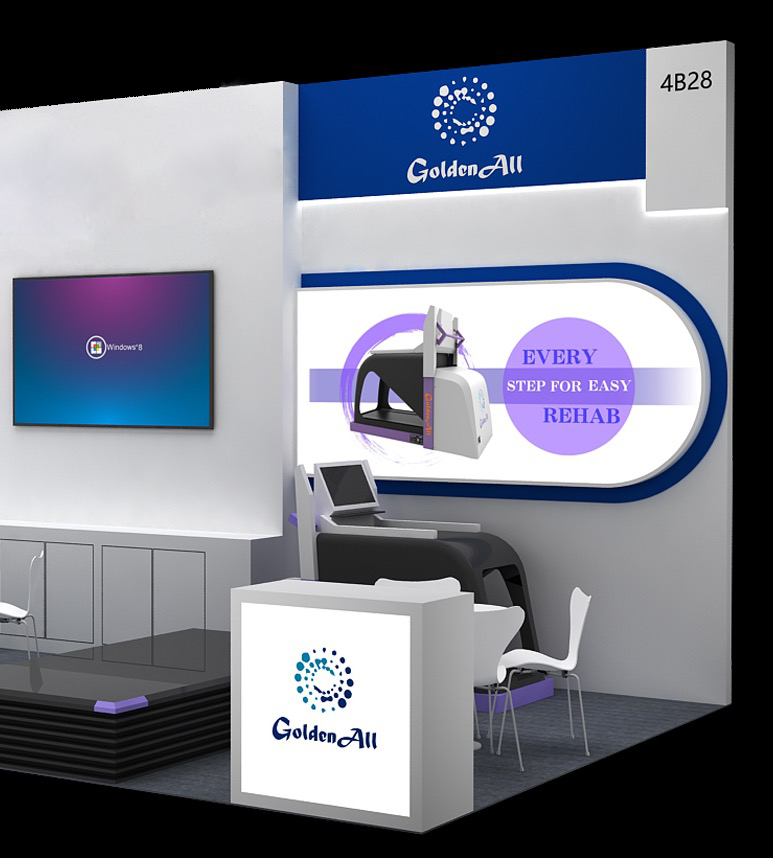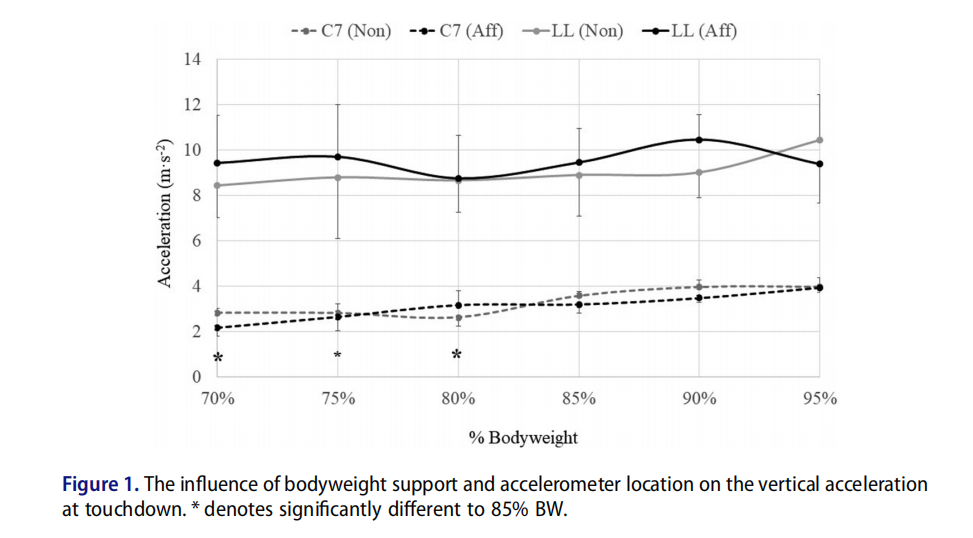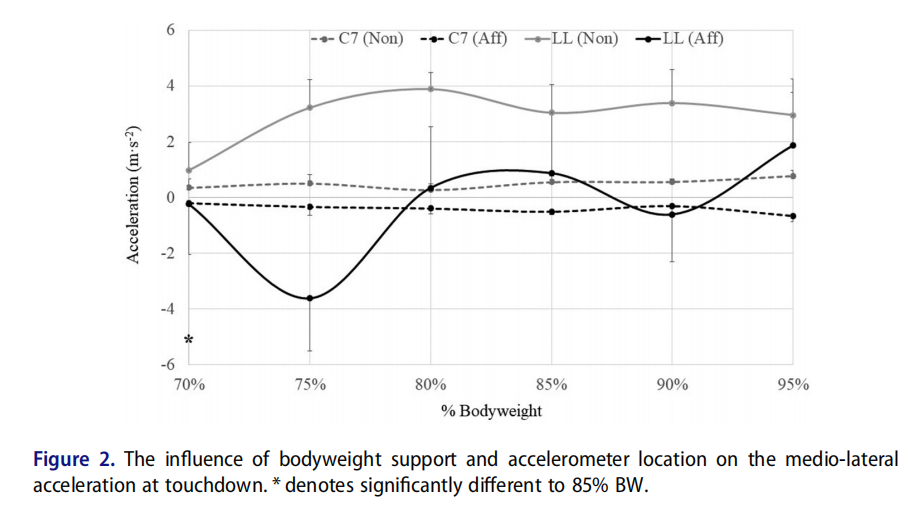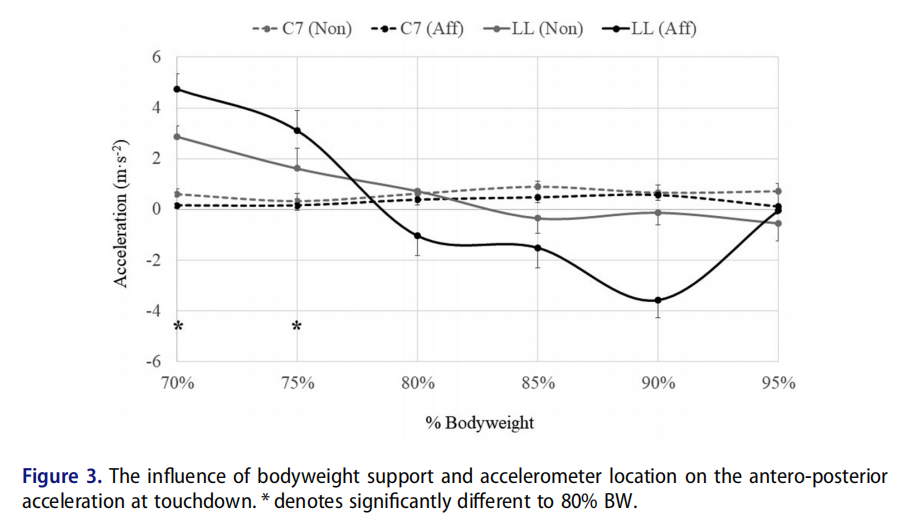Theoretical background:Anti-gravity treadmills have been used in rehabilitation to manipulate exposure to loading and to prescribe return to outside running. Analysis is typically restricted to the vertical plane, but tri-axial accelerometry facilitates multi-planar analysis with relevance to injury mechanism. In this case a professional male soccer player, 4 weeks post-operative surgery to repair a medial meniscectomy, 8 months after Anterior Cruciate Ligament reconstruction to the same knee, completed micro gravity treadmill running at 70–95% bodyweight (BW) at 5% increments. Tri-axial accelerometers were placed proximal to the Achilles tendon of the inj<ured and healthy leg, and at C7. The planar acceleration at touchdown highlighted an increase at 85% BW, identifying 70% and 85% BW as discrete loading progressions. C7 (3.21 ± 0.68 m·s−2) elicited lower (P < 0.001) vertical acceleration than the lower limb (9.31 ± 1.82 m·s−2), with no difference between limbs suggesting bilateral symmetry. However, in the medio-lateral plane the affected limb (−0.15 ± 1.82 m·s−2) was exposed to lower (P = 0.001) medio-lateral acceleration than the non-affected limb (2.92 ± 1.35 m·s−2) at touchdown, indicative of bilateral asymmetry. PlayerLoad during foot contact was sensitive to accelerometer location, with the affected limb exposed to greater loading in all planes (P ≤ 0.082), exacerbated at 90–95% BW. Tri-axial accelerometry provides a means of assessing multiplanar loading during rehabilitation, enhancing objective progression.
Purpose:The aim of the present study was to investigate the multi-planar loading response to a linear increase in % BW during anti-gravity running, conducted as part of the rehabilitation pathway of a professional male soccer player post knee surgery. The uni-axial acceleration at touchdown did not display a linear increase with the step progression in % BW, but there was evidence of an inflection point at 85% BW in vertical and mediolateral acceleration, and at 80% BW in antero-posterior acceleration. Above 85% BW there was no progressive increase in loading, and thus 70% BW and 85% BW represent discrete rehabilitative progressions. In support of this finding, Saxena Granot, (2011) concluded that being able to run at 85% BW was sufficient to safely recommend running outside with full bodyweight for patients following Achilles tendon surgery.
Article cited in:Greig M, Mason L, Mitchell A. Tri-axial loading response to anti-gravity running highlights movement strategy compensations during knee injury rehabilitation of a professional soccer player. Res Sports Med. 2023 May 24:1-11. doi: 10.1080/15438627.2023.2216824. Epub ahead of print. PMID: 37221851.
Introduce:Progressive exposure to weight-bearing activity is a fundamental element of rehabilitation for many lower extremity injuries. Reduced or anti-gravity treadmills allow for the prescriptive manipulation of lower extremity weight-bearing load, potentially facilitating an earlier return to running activities in rehabilitation and enhance post-operative recovery (Eastlack et al., 2005; Hambly et al., 2017). The magnitude of reduction in bodyweight (BW) load has been observed to influence vertical plantar in-shoe pressure (Thomsonet al., 2017) and tibiofemoral force (Patil et al., 2013) so that anti-gravity treadmill might enable a progressive adaptation of loading tolerance without exposure to higher speed running. However, the previously cited literature has only quantified force in the vertical plane, a limitation of in-shoe pressure systems and negating the multi-planar mechanism of injury mechanism. Thomson et al., (2018) reported asymmetry in vertical force during running in ACL reconstructed athletes. Given the mechanistic association of knee valgus with ACL injury, for example, a multi-planar consideration of force during micro-gravity running during rehabilitation is warranted.

Experimental method:The case was a 26-year-old male professional soccer player, typically employed as an attacking midfielder or forward, with 300 appearances, and with no previous history of injuries. The player suffered an ACL rupture to his right (dominant) knee during match>play with surgical intervention to harvest a four-strand autologous hamstring semitendinosus and gracilis graft from the contralateral limb. Eight months into the rehabilitation pathway the player reported pain in the medial aspect of the same knee and underwent a medial meniscectomy. The subsequent rehabilitation was conducted by medical staff from the professional club, and written consent was provided by the player in accordance with the Helsinki Declaration.
Rehabilitation programme:At 4 weeks post-surgery the player had completed a battery of strength and physical capacity tests including knee flexor and extensor isokinetic dynamometry trials to the desired ≥90% limb symmetry index. The player had completed water- and subsequent land-based sessions focusing on running mechanics, with no evidence of bilateral asymmetry or observable limp. The player had also been exposed to progressive loading having performed plyometric drills including a hop test battery, with no evidence of movement compensations in the injured or contralateral limb. Based on successful progression through the objective rehabilitative markers at this stage, the player was deemed ready to begin running on an anti-gravity treadmill (Alter-G, Fremont, CA, USA). At 4 weeks post-surgery the player completed 2-min running intervals at 10.2 km/h with linear progression from 70% to 95% BW at 5% increments. Linear progression rather than a randomized allocation of speed was used to reflect the rehabilitation context of the player. This running speed was equivalent to 30% of the player’s maximum running speed determined from match-play and had been achieved during grass-based rehabilitation sessions in the preceding week. This is slower than the arbitrarily selected 60% of preinjury maximal speed used by Taberner et al., (2020) used at 5.5 months post-surgery, but consistent with our rehabilitation pathway, the stage of rehabilitation and the running speed achieved on the field.



Discussion:This case considers the efficacy of anti-gravity treadmill running 4 weeks into a rehabilitation pathway for a professional male soccer player. There was no evidence of a progressive, linear increase in multi-planar impact acceleration as loading was increased from 70 to 95% BW. Rather, an inflection point at 85% BW suggests that 70% and 85% BW represent unique loading challenges, with practical implications for rehabilitation and exercise progression. The affected limb was not exposed to greater vertical impact acceleration but the medio-lateral acceleration at impact was lower in the affected limb, indicative of movement compensations and bilateral gait asymmetry. Practitioners should therefore adopt a tri-axial consideration of loading and consider placement of the accelerometer as the lower leg was exposed to greater loading than the traditionally used C7. The sensitivity of loading metrics to this case suggests that tri-axial accelerometry can provide an efficacious and accessible means of performing in vivo monitoring during rehabilitation, advocating an emphasis on movement strategy (e.g. axial loading) rather than task outcome (e.g. running speed).
Anti gravity treadmills may induce kinematic changes in running technique, including cadence, vertical center of gravity displacement, ground contact time, and flight time. The lack of such observations in this player may reflect their degree of habituation to the anti-gravity treadmill, the relatively low running speed and the flat running gait typical of football players, as their functional focus is on agility.